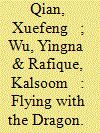| Srl | Item |
| 1 |
ID:
156445


|
|
|
|
|
| Summary/Abstract |
This paper analyzes whether the slowdown of China's trade in 2012–2015 was cyclical or structural, and further discusses the effects of structural factors, including trade structure, trade protectionism and global value chain participation. Using the national panel data from 2000 to 2015, based on the error correction model and import-intensity-adjusted demand model, our results show that the slowdown of China's trade growth in 2012–2015 was mainly a result of cyclical factors. Using 2000–2015 industry-level data, we also find that the structure of trade goods had an inhibitory effect on the import slowdown but a positive effect on the export slowdown. Trade protectionism had an adverse effect on the trade growth slowdown. The global value chain participation marginally contributed to the slowdown in trade growth. Therefore, the impacts of structural factors on trade growth slowdown cannot be ignored, and related policies should receive greater attention from policy-makers.
|
|
|
|
|
|
|
|
|
|
|
|
|
|
|
|
| 2 |
ID:
175571


|
|
|
|
|
| Summary/Abstract |
As a large trading nation, China competes with importing countries’ domestic and third‐country markets but also creates growth opportunities for exporters. Most studies on China trade shocks or “China shocks” focuse on the impacts of import competition on developed economies. The present paper complements research on China shocks by exploring the other side of the trade exposure to China – China as the largest importer, rather than as an exporter. We analyze the effects of export expansion into China on the local labor markets of the exporting developing countries for the years 1992 to 2018. Using detailed export and employment data, we estimate employment pattern variations in manufacturing industries with exports from other developing countries as instruments for export exposure. We find that the increase in trade exposure to China in the world economy has caused extensive job gains in manufacturing industries in developing countries that were exporters. On average, our estimations show that this trade exposure created approximately 1.5 million additional jobs from 1992 to 2018, which made an important contribution to manufacturing industries in developing countries. Our empirical analysis also shows that trade had stabilizing effects on employment in the countries in our sample generally.
|
|
|
|
|
|
|
|
|
|
|
|
|
|
|
|